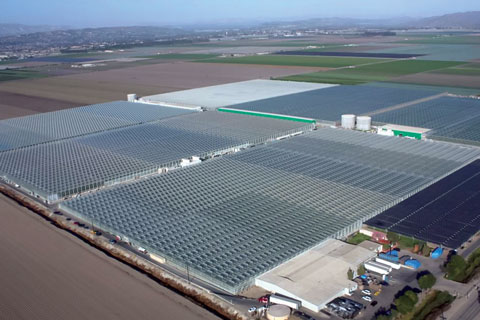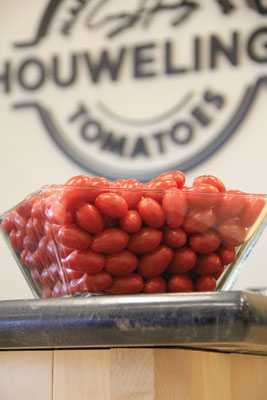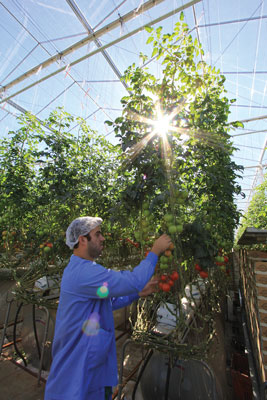6/1/2022
Casey Houweling on Everything Else
Chris Beytes

This story was prompted by the news last August that Houwelings had sold its 5.5 million sq. ft. Camarillo, California, greenhouse to Glass House Brands, one of the largest cannabis growers in the state.
Wow!
A week later came a press release stating that Houweling US Holdings would be rebranding as Longvine Growing Co.
Huh?
Then in September came yet another press release, this time informing us that Houwelings was turning over the marketing of all its products to competitor Mucci Farms.
What the …?
Confused? So were we. So we reached out to Casey for enlightenment. In a phone interview, he straightened out the multiple news stories and provided more details that never made it into press releases.
The tale actually starts not in 2021 but in 2019, when Casey sold his Camarillo and Utah operations to the private equity firm Equilibrium Capital. (He retained his original 50-acre Delta, British Columbia, headquarters.) Equilibrium called the venture “Houweling US Holdings.” Casey leased Camarillo and Utah back from Equilibrium and kept growing produce. That relationship lasted a year before Casey opted out of the lease and Equilibrium took over day-to-day operations. (He won’t say on the record why that happened.)
When Casey split with Equilibrium, he retained the option to repurchase the Camarillo facility. He did so—indirectly, through Glass House. Glass House is using 40 acres to grow cannabis and Casey is using the remaining 85 acres to grow vegetables. Meanwhile, Equilibrium had to stop using the Houweling US Holdings name (“They used it a lot longer than they were supposed to,” Casey says). They chose the new name “Longvine Growing Co.”—which answers that mystery!
 An intriguing bit of backstory is how Glass House came to be able to grow cannabis in Casey’s greenhouse in the first place: Casey founded an entity called “Glass Investment Projects,” through which he worked to get a proposition called “Measure O” put forward to legalize cannabis production in Ventura County. The proposition, which passed, allows cannabis production, but only in pre-existing greenhouses or indoor facilities. It limits production to 500 acres total; a consultant calculated that there are 220 acres in Ventura County. Casey’s 125 acres is more than half that.
An intriguing bit of backstory is how Glass House came to be able to grow cannabis in Casey’s greenhouse in the first place: Casey founded an entity called “Glass Investment Projects,” through which he worked to get a proposition called “Measure O” put forward to legalize cannabis production in Ventura County. The proposition, which passed, allows cannabis production, but only in pre-existing greenhouses or indoor facilities. It limits production to 500 acres total; a consultant calculated that there are 220 acres in Ventura County. Casey’s 125 acres is more than half that.
“It was an economic decision,” Casey explained when we asked him about Glass Investment Projects. “You have to do what you want to do to maintain your business. And we’ve also got responsibilities to employees and everyone else involved in the business, whether it’s suppliers, bankers or whoever else … You know, we’re not only in this for money, we’re in this to make the world a better place and to supply work for people. Of course, to do all these kinds of things you have to make money. This was basically what we needed to do to maintain this company and to maintain the site.”
How long will Casey have access to the greenhouse space?
“We’ll have to see how their part of the business goes,” he replied. “They have the ability to expand … how long could that take, three years, five years, 10 years? Who knows? Let’s see where the world goes.”
And as for Casey’s view of the cannabis business—which is now keeping his tomato business in operation?
“Let’s say it this way: Those guys—Glass House—are cannabis guys. I’m at heart a tomato guy, a produce guy. I’ve never smoked weed in my life, I’m not about to start. You know, they’ve gotta do their thing. I prefer to stick to the tomato and cucumber side of the business.”
Lastly, we asked about that Mucci Farms press release. Casey explained that all of Houwelings veggies from Camarillo will now be marketed by Mucci, carrying the brands of both companies. Why? See “… His biggest mistakes,” below.
Casey on …
Up to speed on the business transactions, we next asked Casey for his current opinions of some of the topics from that first story nine years ago:
 … Labor
… Labor
“The Achilles heel of high-labor agriculture,” he says.
“I’m talking from a California perspective right now, but on January 1, we have minimum wage going to $15 an hour. Plus—and this one is probably worse than the $15 an hour—overtime after 40 hours. (California has reduced what used to be 60 hours prior to overtime kicking in down to 40 hours in the last five years.) Who, in their ultimate wisdom, figures that ag can work on a 40-hour work week? Our labor goes up and down, we can’t control it; we’re not factories, right? We can’t schedule three shifts or whatever else. This is a huge problem for American agriculture.
The solution? Don’t offer anyone overtime.
“They [politicians] don’t really get it. When they put overtime over 40 hours, that hurts the company AND it hurts the employee, because they’re not going to make more money, they’re going to work less hours.”
… Guestworker programs
Paying employees is one thing. Finding them is another. Nine years ago, Casey called the H-2A program “a huge problem,” and he hoped then-President Obama would improve it. Today?
“It hasn’t gotten any better,” he says.
“The biggest advantage Canada has [besides the exchange rate] is they’ve got a good foreign worker program. The H2-A program is quite a bad program for the [greenhouse] vegetable industry because the vegetable industry operates 12 months out of the year, and H2-A is only 10. What do you do for the other two? I’ve spoken about this with the USDA and a whole bunch of other people who are willing to listen, but nothing ever ends up happening on this thing!”
Another benefit of a good guestworker program? “It’s the best form of foreign aid you can get,” he says, “putting money directly into the pockets of people who will send it home to their families to improve their lives—no corruption or waste. The one reason the third world is the third world is because of corruption. And because people don’t have hope. There’s a reason tens of thousands of people are streaming across the borders.”
… Automation
“In today’s world, where labor is such a high percentage of your costs, you’ve got to automate,” Casey stated. “And in order to automate, you’ve got to have less varieties, less crops, because that’s how you automate, through specialization. Automation is the absolute only answer if we’re going to compete here in America against Mexico” where the current minimum wage for agricultural workers is $7.82 per day.
We asked him how far away we are from a fully automated tomato greenhouse.
“We’ve been working with a robotic company. But you know, it’s not there yet. The cost of robot-picking of grape tomatoes, for example, which is highly labor intensive, it’s not there—they haven’t been able to come to a point where the accuracy is good enough to pick. They can do it, but it’s too slow. It’s too costly. Will they get there? For sure … or at least I think so.”
… Startups
Nine years ago, Casey said urban and vertical farm startups would find it “very challenging,” and there would be “a lot of casualties along the way.” We asked his opinion of startup AppHarvest in Kentucky (which had raised more than $500 million in capital before growing its first tomato, but which had lost $17.3 million between July and September 2021.)
“In a nutshell, that’s the Canadian cannabis industry repeated,” he said. “Meaning the big bubble, all the money that poured into it—not millions, but billions that poured into that industry—and it was all euphoria. It’s the same with Kentucky. There’s no labor there. And the whole discussion about getting coal miners to pick tomatoes? Good luck!”
One urban ag startup that impresses Casey is Lufa Farms of Quebec, a rooftop greenhouse operator that, ironically, we also profiled in that first edition of Inside Grower.
“But they use it as a huge selling point, right?” Casey points out. “They’re direct production to retail. And the guy that runs that place [founder Mohamed Hage], he’s a genius! … He built them right at the busiest intersections of freeways he could see, and that’s big advertising for them.”
… Alternative energy
Casey thinks a lot about the high cost and volatility of energy and the untapped opportunities to make use of waste energy. (See “… His biggest mistakes,” below.)
“It drives me nuts!” he exclaims. “We waste more energy in America, and if we just coordinated the energy wasted coming from power plants or whatever else and we tied that into the greenhouse sector, we could be carbon neutral, easy!”
That’s why Casey is in the process of planning for a greenhouse in Jamestown, North Dakota, where the greenhouse will harvest waste heat and CO2 from an ethanol plant (which, in turn, is harvesting waste steam from a coal-fired power plant).
“That’s an absolute, almost best-case scenario,” he says of the project. “I just wish it was in a little warmer place than Jamestown!”
Casey also hinted at geothermal (he recently gave a talk at an energy conference at Chena Hot Springs Resort in Fairbanks, Alaska). But he wouldn’t say more on the topic. We’ll just have to wait and see.
“I like doing these kind of projects, I think they’re a lot of fun,” he says. “I like the idea of having a greenhouse operating where you’re basically not adding any CO2 or using any energy.”
… His biggest mistakes
“How many days do you have?” Casey joked when we posed this question. He offered three:
1. “Our marketing company never, ever should have existed. Our company would have been a whole lot more successful without it. We’ve got a good brand. But we never did a good job marketing that brand. Long ago in my career I should have decided I was a producer, not a marketer.”
2. “Back in the Enron days, natural gas in California went up to over $100 per MMBtu. The price was so high, the price of gas exceeded our revenue. We made it through that bump, Enron went bankrupt, and I locked in gas for 10 years at $8.70 per MMBtu. And over that 10-year period, natural gas went down to between $2 and $3 per MMBbtu. That deal cost me 12 million bucks.”
3. Casey quit school at age 15 because “I thought I could do everything better myself,” he admits. “That’s the biggest mistake you can make as an entrepreneur. I managed to plug my way through it because I worked my ass off. But you know what? It took me a long time—way too long—to figure out that other people sometimes know things better than you do, and you can’t do everything better yourself. I know that now.”
… on his—and Houweling’s— future
“I’m 63 years old. And I’m thinking ‘What am I gonna do?’ I’m not going to live forever. I’m highly unlikely to still be working when I’m 91, like Warren Buffet. But I don’t want to become irrelevant. Whether that is working with projects in Guatemala, or North Dakota or wherever. And making sure my kids and grandchildren are all doing well.”
 Casey and his wife, Linda, have three daughters, all with university degrees. Monica (Houweling) Paulson has been in the family business since that first interview in 2012. Today, she’s married, with two children (one born this past December 31), and she has climbed the ladder to account manager. Says Casey of his middle daughter, “She’s brilliant—she’s way smarter than I am. She’s got a business degree from Pepperdine. I tell you, if I died tomorrow and she became CEO, the company would be a lot better for it.”
Casey and his wife, Linda, have three daughters, all with university degrees. Monica (Houweling) Paulson has been in the family business since that first interview in 2012. Today, she’s married, with two children (one born this past December 31), and she has climbed the ladder to account manager. Says Casey of his middle daughter, “She’s brilliant—she’s way smarter than I am. She’s got a business degree from Pepperdine. I tell you, if I died tomorrow and she became CEO, the company would be a lot better for it.”
But it’s when Casey talks about his two grandsons that his voice really lights up.
Pictured: Jacob Casey Paulson, fourth-generation greenhouse man in the making.
“You know what, the thing is, there’s nothing like having a grandchild running up to you holding his hands out. [Nineteen-month-old Jakey] hasn’t quite figured out everything in life—he calls me ‘Out’ instead of grandpa. I don’t know where the word ‘Out’ comes from … because I take him outside all the time, probably.”
Does Jakey have a future in the greenhouse business?
“I’m working on it already. You’ve gotta start when they’re young. I could send you a picture of him pulling up a flower in his yard and looking at it … this kid’s a natural!” IG